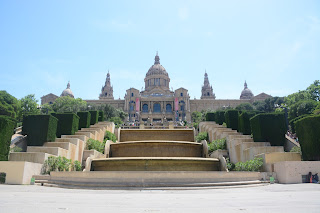Photography 101: What is Shutter Speed?
I love photography, especially travel
photography, and I’d like to help you out with some basic photography tips
so you can start capturing the world with your DSLR.
The three most important terms in photography:
- Shutter speed
- ISO
- Aperture (also called F-stop)
- ISO
- Aperture (also called F-stop)
These three things are the pillars that any great photographer builds his masterpieces upon. And when you know how to make them work together you will start creating some wonderful photos.
Let's talk about shutter
speed, what it is, and why it matters
 Shutter speed is the amount of time that your shutter is
open. When you take a picture and hear that ‘click,’ that’s the sound of the
shutter opening and closing. The shutter covers the camera sensor- basically the
eye ball of the camera- and when the shutter opens we get a picture.
Shutter speed is the amount of time that your shutter is
open. When you take a picture and hear that ‘click,’ that’s the sound of the
shutter opening and closing. The shutter covers the camera sensor- basically the
eye ball of the camera- and when the shutter opens we get a picture.
Shutter speed is measured in seconds, and if you see, 1/1000,
that means the shutter is open for 1/1000 of a second. This is a pretty fast
shutter speed. 1/125 is a fairly average speed. A slower shutter speed would be
something like 2 seconds.
Why is shutter speed important? Two reasons. Movement and
Light.
Movement:
Sometimes we take pictures of football games, or playing babies,
or running horses- and these things all move. We can’t really stop them. So we
have to input the right shutter speed to capture the image just how we want it.
I have three photos below that are centered around movement.
Let’s look at the difference between the photos and their shutter speeds. The
shutter speeds are 1/5 (Slow). 1/50 (A little slow). 1/2500 (Very fast).
Thailand fire show – Shutter speed: 1/5 – This is a slow speed, and this allows you to see that the sparks are long and stretched. This creates a beautiful blur across the photo.
Thailand Fire show
Snowball in face
So you need to consider if your subject is moving or not. The snowball was moving fast and I wanted a very sharp picture, so
that called for the fast shutter speed. However in Thailand, I wanted a
beautiful, bright photo, with lots of color smeared across it- so I used 1/5.
You must also consider the movement of your own hand. If you
have a steady hand, then you can do well in the slower shutter speeds, such as
1/5 or 1/50. If you know you have shaky hands, then you will need to keep a
quicker shutter speed.
Light:
It’s important to consider the movement of your subject, but
now you need to think about light as well.
Your camera won’t work without any light present, so we must
ALWAYS consider how much light there is when we’re looking at our settings. A
slow shutter speed, such as 1/5, lets in a lot of light, and so this is ideal
for a night scene.
1/50 is a little slow, and is ideal for photographing
indoors, as well as sunsets and sunrises- anywhere with minimal light.
1/400 is fast, and this lets in only a little light. Because
of this, 1/400 must be used in a very bright area.
Below are some examples of bad photography. I used the wrong
shutter speed intentionally, so you can see how shutter speeds can be misused.
– 1/5 – This is a cat in my back yard, but it’s hard to
tell what it is. A 1/5 shutter speed lets in so much light that the picture is
almost unrecognizable.
– 1/50 – Here, too, you can see that there is just too much light
coming in through the shutter. The picture is recognizable, but it just doesn’t
look good; the dust is practically white because there is so much light coming in.
– 1/400 – This is a photo of the same cat from above. While the 1/5
lets in A LOT of light, the 1/400 only lets in a little so this photo is too
dark. If I had used the same shutter speed as I had with my friend and the snowball, (1/2500) this picture would just be black.
In
summary:
– 1/5 – Lets in a lot of light. Good for dramatic night shots. Makes moving objects blurred.
– 1/50 – Lets in a good amount of light. Makes moving objects a little bit blurry.
– 1/400 – Lets in a little light. Ideal for daylight. Ideal for stationary or slow moving objects.
– 1/2500 – Lets in very little light. Ideal for bright daylight. Makes moving objects incredibly sharp.
So remember, when you're in a place with a lot of light, you want a fast shutter speed.
Here are some good uses of shutter speed
Man on Truck
Thailand Beach
Thanks so much for checking out the blog. You can always comment below if you have any questions.
Coming soon: ISO settings. How to make pictures brighter, even at a fast shutter speed.
What is Aperture (F-stop) and why does it matter?
And please check out my friends' blogs! They're fantastic.




































































